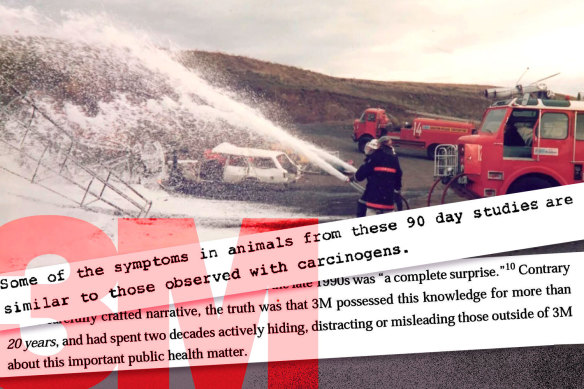$58 billion day of reckoning looms for 3M over toxic ‘forever chemicals’
Snapshot
- PFAS or ‘forever chemicals’ are contained in everyday items such as non-stick cookware, school uniforms and firefighting foam as they repel grease, oil and water.
- Their use has been linked to a range of illnesses but the potential health effects remain hotly disputed.
- In 2020, the Australian government paid $212 million to three communities polluted by foam used on military bases.
- 3M, one of the main American manufacturers of PFAS, is facing up to $US40 billion in legal liabilities after being hit with thousands of lawsuits over the chemicals. It will fight the allegations.
Global chemicals maker 3M will be accused of a decades-long campaign to deceive the public about the risks of its controversial “forever chemicals” as it faces a series of bombshell legal claims worth up to $US40 billion ($58 billion) that a judge described as an “existential threat” to multiple defendants’ survival.
The Wall Street giant is bracing for a landmark legal trial in the United States beginning in June over its use of the family of per- and poly-fluoroalkyl chemicals, known as PFAS. In Australia, the chemicals have contaminated at least 90 sites and officials have acknowledged PFAS has contaminated the blood of up to 98 per cent of the world’s population.
3M is facing an unprecedented lawsuit over toxic ‘forever chemicals’.
Dubbed “forever chemicals” because they do not break down in the environment and stay for years in the human bloodstream, PFAS was formerly the key ingredient in 3M’s popular fabric protector Scotchgard because of its unique ability to repel grease, oil and water.
Scientific studies linking the chemicals to cancer and a slew of other health effects have given rise to mounting public health concerns for governments internationally.
3M is the largest target among a string of corporations being sued in the multidistrict litigation, which the federal court has chosen to run through the District of South Carolina.
The mammoth case has absorbed the claims of 18 US states and territories as well as more than 100 water providers demanding compensation to filter PFAS from drinking water supplies.
It will also canvass the claims of thousands of individuals alleging they have suffered personal injury from the toxins, including testicular and kidney cancer.
The plaintiffs are seeking compensation for economic loss, damage to the environment, personal injury and medical monitoring over the use of PFAS in aqueous film-forming foams (AFFF) at airports, military bases, fire stations and industrial sites.
3M will stop making so-called forever chemicals.Credit:Bloomberg
Since it was first filed in 2018 the case has ballooned to include more than 3300 claimants, making it the largest PFAS litigation on foot in the United States.
Documents beginning to emerge from years of discovery are expected to cause angst on Wall Street as 3M faces fresh allegations of concealing the health risks of PFAS and their widespread presence in human blood.
“The truth was that 3M possessed this knowledge for more than 20 years, and had spent two decades actively hiding, distracting or misleading those outside of 3M about this important public health matter,” court filings said.
In a statement, a 3M spokeswoman said it would vigorously defend its record of environmental stewardship.
“3M acted responsibly in connection with products containing PFAS,” she said.
“AFFF was a critical tool developed to serve an important need for military service members and other responders facing high hazard, potentially life-threatening challenges.”
Two of the most notorious in the family of chemicals – PFOS and PFOA – were used in the firefighting foam but were phased out by 3M in the early 2000s.
“Exposure to PFOA and PFOS at current and historical levels found in people and the environment has not been shown to cause adverse health effects,” the spokeswoman said.
She said 3M made provisions for “probable and reasonably estimable” liabilities and provided disclosures about the status of litigation.
According to a Bloomberg Intelligence report, 3M is facing a $US40 billion threat to its bottom line as a result of the 14,000 lawsuits filed against it in the United States over water contamination caused by PFAS.
Author Holly Froum found remediation costs were potentially worth up to $35 billion payable over 30 years, and personal injury, medical monitoring and property damage claims were worth as much as $5 billion.
‘This case presents an enormous risk to 3M financially should they lose.’
“If 3M must face trial, as we expect, it could fare poorly with juries,” Froum said.
Under her estimate, the legal liability represents nearly two-thirds of the Fortune 500 company’s $US66 billion market capitalisation, with its alleged tactics around PFAS previously compared to those weaponised by the asbestos and tobacco industries.
With new claimants signing up to the South Carolina litigation every week, lawyers are yet to specify the size of the overall claim.
Among the litany of allegations of corporate malfeasance to be aired will be claims a scientist warned 3M representatives as far back as 1979 that the chemicals appeared to behave similarly to carcinogens in animal studies – before the comment was deleted from meeting minutes.
The case will probe the extent of internal 3M concerns about the health effects of PFAS in open court for the first time, with the company having publicly denied for years that the chemicals posed any risk to human health.
The first leg of the litigation will deal with the cases involving water providers, with a claim by the City of Stuart in Florida against 3M the first to be tried in June.
Gary Douglas, a partner at New York law firm Douglas and London, will represent the city as lead trial counsel.
He told the Herald and the Age the city was fighting to recoup in excess of $100 million spent on removing the “cancer-causing” toxins from its water, which bore a unique chemical signature showing they were manufactured by 3M.
Douglas said Stuart was selected as a “bellwether” case because it was considered representative of many of the other cases pending in the litigation.
“Accordingly, the jury’s verdict in this case will have enormous repercussions,” Douglas said. “This case presents an enormous risk to 3M financially should they lose.”
Douglas said while the story of PFAS was only just beginning to come to light, it was well established that PFAS could be found in everyone and everywhere on planet Earth.
“The blood of the polar bears in the North Pole, on the snow high atop Mount Everest and in the fish in the deepest parts of the ocean,” he said.
“We intend to reveal for the first time in open court the entire story of 3M’s role in causing likely the worst environmental disaster in the history of mankind.”
The case has been assigned to Judge Richard Gergel, who was nominated to serve in the District of South Carolina by former president Barack Obama in 2009.
Gergel warned that if certain motions didn’t go their way, “the defendants are in an existential threat to their survival”.
“If you ask the plaintiffs’ counsel, they would say, ‘this is like one of the greatest environmental tragedies in the history of man’ and the defence lawyers said: ‘I’ll drink it by the bottle, and it won’t hurt us’,” Gergel said.
“Somewhere the truth may lie and we’ve got to figure out what is it … unemotionally, rigorously, scientifically looking at the data.”
The lawyer representing the foam manufacturers, Joe Petrosinelli, replied: “Can I give you one thought on that, Judge?”
“You’re not offering to drink it?” Gergel said.
“No, I’m not. I’m not,” Petrosinelli said.
Gergel said the issue of causation would be a major contest in the lawsuit, which would be at the “cutting edge” of the developing science on the chemicals.
The case is expected to reverberate internationally, including in Australia, where dozens of communities have been polluted by the use of the toxic firefighting foams on military bases.
In 2020 the Australian government paid out $212 million to three of those communities to settle a class action lawsuit and a cache of new claims are on foot.
Newer forms of PFAS remain widespread in consumer products, including makeup, school uniforms and nonstick cookware. PFAS was found in the blood of all Australians sampled in a 2016 study by the University of Queensland.
“All Australians are expected to have detectable levels of PFAS in their blood,” the Australian government said in advice issued to general practitioners.
3M has pledged to stop manufacturing all forms of PFAS by the end of 2025.
The plaintiffs’ team is being advised by attorney Robert Bilott, a partner with law firm Taft Stettinius and Hollister, who led a high-profile crusade for justice on behalf of a community polluted by the chemicals in West Virginia.
Bilott said he hoped the litigation would mean critical information about PFAS that had been buried for decades in internal company files would finally be revealed to the world. He argued companies should be “held responsible for the damages and costs associated with this unprecedented disaster”.
The Australian government maintains there is limited to no evidence that exposure to PFAS significantly harms human health.
However, other governments have delivered stark warnings about the health dangers.
In Europe authorities have declared the chemicals can cause health problems such as liver damage, thyroid disease, obesity, fertility issues and cancer.
In the United States, the EPA has found high levels of exposure may raise cholesterol, interfere with hormones, the reproductive and immune system, increase the risk of some types of cancers and lead to developmental effects in children.
3M’s latest annual report noted it was defending multiple lawsuits regarding its PFAS-related products and the outcome was difficult to predict.
“An adverse outcome in any one or more of these matters could be material to our financial results,” it said.
The Morning Edition newsletter is our guide to the day’s most important and interesting stories, analysis and insights. Sign up here.
Most Viewed in National
From our partners
Source: Read Full Article

